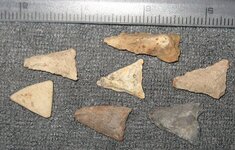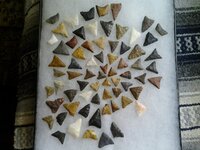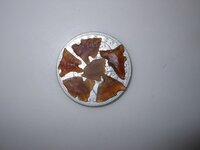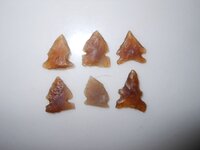Dug
Bronze Member
- Feb 18, 2013
- 1,138
- 1,264
- Detector(s) used
- XP Deus/Sovereign GT.
- Primary Interest:
- Relic Hunting
Hi;
Quite some time ago I was in a farm field in Lobeco SC and eyeballed these small points in amongst Oyster shell, pottery shards, and agate/chert chips. I had the feeling that I was in a small village area since the chips were from point making. The area is less than a mile from a large saltwater creek. For points this small, what sort of use would they be? Fish or birds?
The smooth lower left item may not be a point, but the triangular shape caught my attention and stones are not naturally occurring in this sandy coastal area.
Opinions?

Quite some time ago I was in a farm field in Lobeco SC and eyeballed these small points in amongst Oyster shell, pottery shards, and agate/chert chips. I had the feeling that I was in a small village area since the chips were from point making. The area is less than a mile from a large saltwater creek. For points this small, what sort of use would they be? Fish or birds?
The smooth lower left item may not be a point, but the triangular shape caught my attention and stones are not naturally occurring in this sandy coastal area.
Opinions?

Upvote
0


 Often triangles were knives (btw, the triangle furthest to the left is not worked, and not an point. All edges appear to be smoooooth). You wouln't believe how small true arrow points can be- fitting on the surface of a dime in many cases. When you think of bird points, think of what a modern arrow point looks like- and how small it would have to be to fly right. Now, I'm not expert on fish points, but it (they) could be. I know someone will jump in and explain. I found a ton of triangles on the Eastern Shore, MD, and almost every time, found that they were a little lop-sided...used on one side, re-sharpened- a patterns I would associate w/ a knife.
Often triangles were knives (btw, the triangle furthest to the left is not worked, and not an point. All edges appear to be smoooooth). You wouln't believe how small true arrow points can be- fitting on the surface of a dime in many cases. When you think of bird points, think of what a modern arrow point looks like- and how small it would have to be to fly right. Now, I'm not expert on fish points, but it (they) could be. I know someone will jump in and explain. I found a ton of triangles on the Eastern Shore, MD, and almost every time, found that they were a little lop-sided...used on one side, re-sharpened- a patterns I would associate w/ a knife.









